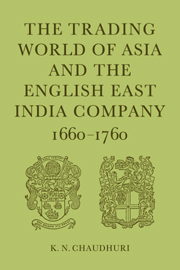Book contents
- Frontmatter
- Contents
- Tables
- Figures
- Maps
- Abbreviations
- Notes on dates, contemporaneous spellings, currency, and weights
- Preface
- Acknowledgements
- 1 The international economy and the East India trade
- 2 A formal theoretical model of the East India Company's trade
- 3 The structure of early trade and the pattern of commercial settlements in Asia
- 4 The evolution of the Company's trading system: operation and policy 1660–1760
- 5 Long-term trends and fluctuations 1660–1760
- 6 Politics of trade
- 7 Markets, merchants, and the Company
- 8 The export of treasure and the monetary system
- 9 The structure of country trade in Asia
- 10 Export of European commodities
- 11 The Company and the Indian textile industry
- 12 The Company's trade in textiles
- 13 Pepper
- 14 Import of bulk goods
- 15 Raw silk
- 16 Coffee
- 17 Imports from China
- 18 Financial results
- 19 Conclusion
- APPENDICES
- General glossary
- Bibliography
- Short titles cited in the reference notes
- Notes
- Index
10 - Export of European commodities
Published online by Cambridge University Press: 06 July 2010
- Frontmatter
- Contents
- Tables
- Figures
- Maps
- Abbreviations
- Notes on dates, contemporaneous spellings, currency, and weights
- Preface
- Acknowledgements
- 1 The international economy and the East India trade
- 2 A formal theoretical model of the East India Company's trade
- 3 The structure of early trade and the pattern of commercial settlements in Asia
- 4 The evolution of the Company's trading system: operation and policy 1660–1760
- 5 Long-term trends and fluctuations 1660–1760
- 6 Politics of trade
- 7 Markets, merchants, and the Company
- 8 The export of treasure and the monetary system
- 9 The structure of country trade in Asia
- 10 Export of European commodities
- 11 The Company and the Indian textile industry
- 12 The Company's trade in textiles
- 13 Pepper
- 14 Import of bulk goods
- 15 Raw silk
- 16 Coffee
- 17 Imports from China
- 18 Financial results
- 19 Conclusion
- APPENDICES
- General glossary
- Bibliography
- Short titles cited in the reference notes
- Notes
- Index
Summary
General policy
A remarkable feature of contemporaneous economic thinking on international trade was the expectation that each commercial area with which a particular country had bilateral relations should generate its own purchasing-power and thus become self-financing. Whether it was trade with Spain and Portugal, France, or the Baltic, the desirability of balancing the respective exports and imports was seldom questioned. When overseas trade is relatively unrestricted and the financial institutions connected with it are sufficiently developed, it is unnecessary for merchants themselves to engage in a two-way traffic. The task of financing the exports or imports properly belongs to the banks which handle the foreign exchange market. By the end of the seventeenth century even English overseas trade was drawn into the ever-extending orbit of the European multilateral exchange mechanism. There was still one notable exception, however, the trade of the East India Company remained in a very different situation. Its legal monopoly effectively prevented the emergence of a competitive bill market until the private trade of its own servants, along with the trade of free European merchants, created in Asia a limited source of capital under foreign ownership. Although interregional trade in India was extensively financed through well-established networks of credit instruments, so far as Europe's trade with the Indies was concerned exponents of economic policy in the seventeenth and eighteenth centuries still laboured under a heritage of ideas derived from the days when international commerce was conceived of only in terms of bilateral relations.
- Type
- Chapter
- Information
- The Trading World of Asia and the English East India Company1660-1760, pp. 215 - 236Publisher: Cambridge University PressPrint publication year: 1978



